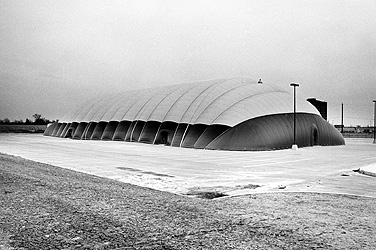Flashback
35 years ago
Bubble opens on North Campus

It was “green, white and ugly,” and located between O’Brian Hall and the Ellicott Complex. It was described as “a plump glowing caterpillar” or “something that had lost a race with the Goodyear Blimp.” For a brief period, The Spectrum linked it to UB’s president, Robert L. Ketter, by calling it the “Ketterpillar.” It was the Bubble, the highly visible, temporary, recreational facility on the North Campus between 1975 and 1984.
Plans to build a temporary recreational facility were announced in January 1974, four months after the first dormitories had opened and the first classes were held on the new campus. A year later, Birdair, a local company and the builder of the U.S. Pavilion at Expo 70, had erected an air-supported structure inflated by continuously running blowers, heated by gas furnaces and insulated by an air pocket situated between a double-skin surface.
At 250 feet long, 120 feet wide and 50 feet high, the Bubble was hard to miss. Its 31,000 square feet held four basketball courts, four tennis courts and facilities for volleyball, badminton, Frisbee and track. When 22 pairs of 1500-watt lamps made the interior brighter than daylight, the wattage had to be reduced. Two trailers adjacent to the structure provided space for locker rooms.
At the end of the Bubble’s first year, the facility was considered a success. Complaints about the lack of a wooden floor—it had been erected on top of an asphalt parking lot—did not keep the 2,500 daily users away.
The weather on the North Campus did cause havoc for the structure. The Bubble had to be re-inflated after the blizzard of 1977 when it fell on basketball hoops and lights, ripping the canvas. Then, a severe storm in late February 1984 caused the Bubble to collapse, which destroyed the ductwork used for blowing air through the two lawyers of canvas.
The plan had been to retain the Bubble until all phases of Alumni Arena had been completed, but the combination of weather and the high cost of repairing the structure prevented that.
The extensive papers of Walter Bird, founder of Birdair and a pioneer of lightweight structural design, were presented to Special Collections of the UB Libraries in 2007. For more information see “Finding Aid for the Walter Bird Papers, 1912-2006.”
—John Edens, University Archives

Reader Comments